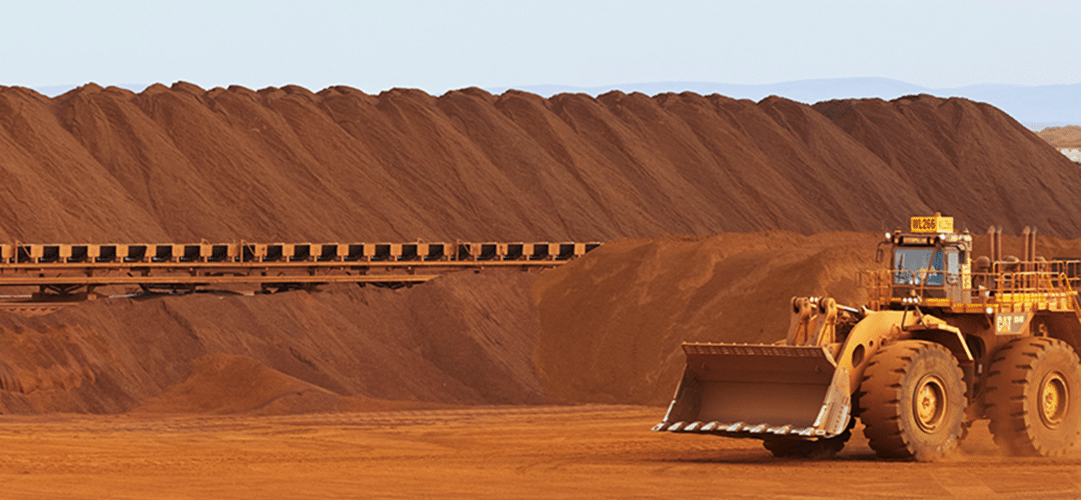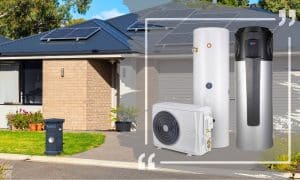Endowed with abundant natural resources, Australia has actively pursued decarbonisation initiatives to address climate change. Fortescue Metals Group, one of the key players in this effort, ventured into the renewable energy sector with its ambitious Pilbara Renewable Energy Project. While the initial phase faced setbacks, incorporating refined storage technologies presents a new avenue of hope for Australia’s decarbonisation journey.
Are you looking to save money on your electricity bills and reduce your carbon footprint? Solar energy is the perfect solution! Energy Matters can help you get up to 3 FREE quotes from pre-qualified and vetted solar firms in your area.
Energy Matters has been a leader in the renewable energy industry since 2005 and has helped over 40,000 Australian households in their journey to energy independence. With Energy Matters, you can be sure you’re getting the best possible deal on solar energy. We only work with reputable solar firms with a proven track record of delivering high-quality solar systems.
The decarbonisation imperative
In a surprising turn, mining giant Fortescue has decided to terminate its plans for a massive 5.4 GW solar, wind, and battery energy storage project in Western Australia’s Pilbara region. The Uaroo Renewable Energy Hub, a multi-billion-dollar initiative, aimed to provide renewable energy to power Fortescue’s iron ore mining operations. This decision, disclosed through documents from the West Australian Environmental Protection Authority (EPA), marks a significant setback in Fortescue’s ambitious goal to decarbonise its mining operations by 2030.
The Uaroo Renewable Energy Hub at a glance
Initially proposed as a crucial component of Fortescue’s decarbonisation strategy, the Uaroo Renewable Energy Hub was designed to occupy a sprawling 10,000-hectare site approximately 120 kilometres south of Onslow. The project comprised a 3.33 GW solar farm, a 2.04 GW wind farm, and an extensive 9.1 GWh battery energy storage system. These elements were strategically integrated to harness solar and wind energy, storing it for later use to ensure a stable and reliable power supply for the mining operations.
Impact on decarbonisation targets
The Uaroo Renewable Energy Hub was a linchpin in Fortescue’s comprehensive plan to reduce carbon emissions from its mining operations. With an annual carbon equivalent generation exceeding 2.5 million tonnes, Fortescue recognised the urgent need to transition towards cleaner energy sources. The abandoned project leaves a significant gap in the company’s roadmap to achieve its decarbonisation target by 2030. Fortescue estimates that an additional 2 GW to 3 GW of renewable energy generation and battery storage will be required to meet its goals.
Alternative plans for decarbonisation
Despite the setback, Fortescue remains committed to decarbonising its operations. In a recent presentation to analysts and investors, the company outlined alternative plans, including constructing more than 1 GW of solar, around 1 GW of wind energy, and about 4 GWh of battery storage. Notable progress has already been made, with a 60 MW solar farm at Chichester completed by Alinta. Additionally, a 100 MW solar farm near the Iron Bridge magnetite operations is nearing completion, and two small battery projects are well advanced.

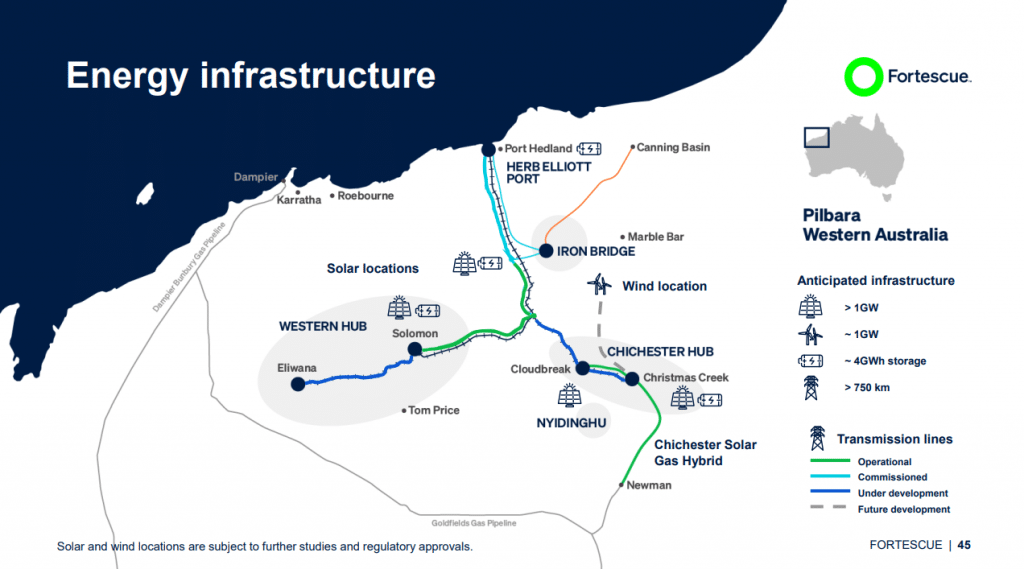
Renewable energy investments
One of the key pillars of Fortescue’s decarbonisation strategy is to reduce its reliance on expensive and polluting gas generation and diesel. The company has outlined plans to construct multiple gigawatts of wind, solar, and battery storage for its Pilbara operations to accomplish this.
Notably, a 60MW solar farm has already been constructed at Chichester, and plans for an additional 150MW of solar capacity and two small battery projects are in advanced stages of development. 750 kilometres of transmission lines are also part of the plan to support these projects.
The timeline suggests that most battery storage projects will commence construction around 2026, with wind projects beginning in 2027. While the exact locations for these initiatives are still being determined, Fortescue’s commitment to green energy is clear.
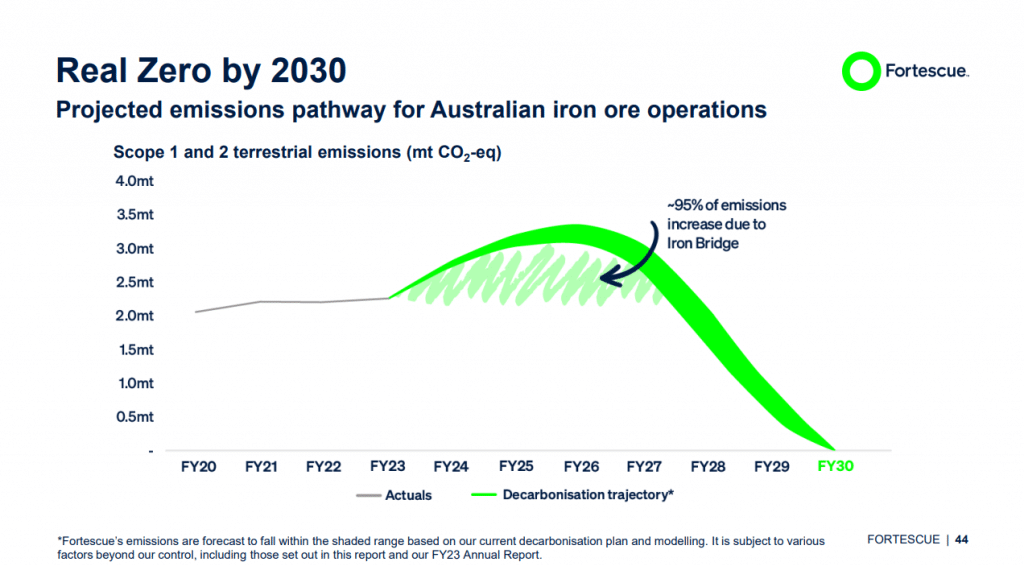
A greener mobility fleet
Zero emissions mobility is a top priority for Fortescue. The company is working on transitioning its fleet of heavy haul trucks, excavators, cars, utes, drills, and locomotives to electric or hydrogen fuel cell vehicles. Initial trials have begun, including electric 260-ton haul trucks and a 3MW charging station. A hydrogen fuel cell haul truck is also being tested at one of its mine sites. Fortescue is committed to electrifying its operations and ensuring a seamless transition to renewable energy sources.
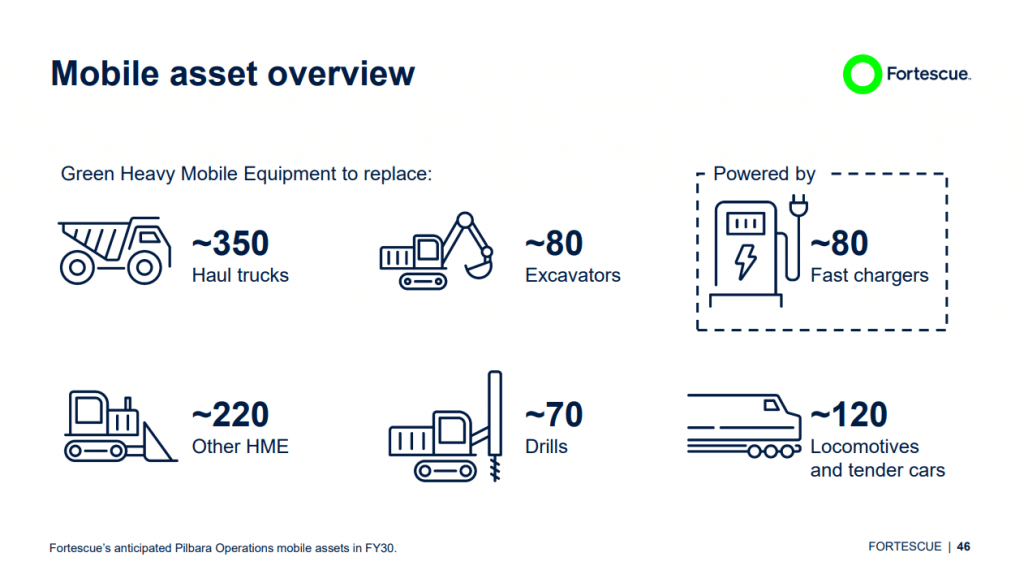
Innovations for sustainable mining
Fortescue’s commitment to sustainability goes beyond energy sources. The company is also exploring innovative solutions, such as modifying a diesel ship engine to run on green ammonia, with sea trials scheduled for the near future. Electric locomotives are expected to arrive in 2024, and the “Infinity train” concept aims to recharge large batteries during downhill transport, ensuring a continuous power supply.
Furthermore, Fortescue is developing prototype exchangeable batteries featuring flexible chemistry and scalability designed for its heavy haul vehicles. The company also tests off-grid hydrogen fuel cell systems for its broader decarbonisation strategy.
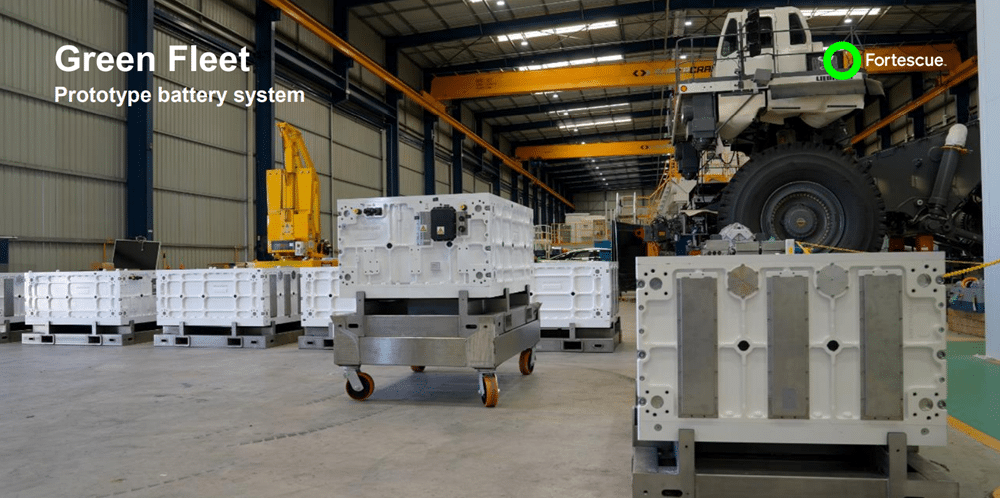
Source&Images: West Australian Environmental Protection Authority (EPA), Fortescue ASX Release: Pilbara Operations Site Tour Presentation 2023
Collaboration in the Pilbara region
Fortescue is not alone in its transition to renewable energy in the Pilbara. Major mining companies like Rio Tinto and BHP invest in wind, solar, and storage projects. However, Fortescue is notably focused on achieving zero emissions, differentiating its commitment from using offsets and setting a higher standard for sustainability.
Environmental impact
While the Pilbara Renewable Energy Project faced setbacks initially, Fortescue’s strategic shift towards refined storage technologies signals a new chapter in Australia’s decarbonisation efforts. The integration of advanced storage solutions not only addresses the challenges posed by renewable energy intermittency but also positions Fortescue as a pioneer in sustainable mining practices. As the project progresses, the lessons learned, and innovations developed could serve as a valuable blueprint for other industries and countries striving to balance economic growth with environmental responsibility in the face of climate change.
Fortescue acknowledges its significant carbon footprint, with over 2.5 million tonnes of CO2 equivalent emissions produced annually from its mining operations, including shipping and tug boat operations. This understanding drives the company’s commitment to change and align with a more sustainable and environmentally responsible path.
Fortescue Metals Group’s transition to green energy represents a significant milestone in the mining industry’s journey towards decarbonisation. With ambitious plans to harness renewable energy, electrify its fleet, and reduce emissions, Fortescue sets a high standard for sustainable resource extraction. As the company forges ahead with its commitment to achieve “real” zero emissions, its efforts serve as a testament to the transformative power of industry leaders in addressing climate change and promoting responsible environmental stewardship. Read more about Net Zero Emissions: Australia’s Accelerating Transition and Pace and Australia: Net Zero Emissions Target By 2050.
Unleash the potential of solar battery storage!

Are you ready to transform the way you power your business or household? Say goodbye to rising electricity costs and unpredictable energy grids. The state-of-the-art solar battery systems empower you to maximise energy efficiency, save money, and reduce your carbon footprint while enjoying an uninterrupted power supply.
Let us discuss and choose the best quote that suits your needs and budget, and we can connect you with our trusted local installers, who will provide up to 3 FREE quotes for your business solar and home battery system.











